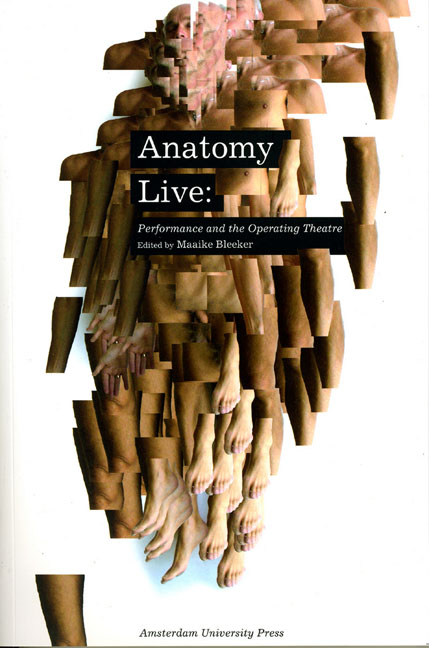Book contents
- Frontmatter
- Contents
- Acknowledgements
- Prologue - Men with Glass Bodies
- Introduction
- Performance Documentation 1: Holoman; Digital Cadaver
- Digital Cadavers and Virtual Dissection
- ‘Who Were You?’: The Visible and the Visceral
- Performance Documentation 2: Excavations: Fresh but Rotten
- The Anatomy Lesson of Professor Moxham
- ‘Be not Faithless But Believing’: Illusion and Doubt in the Anatomy Theatre
- Performance Documentation 3: De Anatomische Les
- Of Dissection and Technologies of Culture in Actor Training Programs – an Example from 1960s West Germany
- Ocular Anatomy, Chiasm, and Theatre Architecture as a Material Phenomenology in Early Modern Europe
- Performance Documentation 4: Camillo – Memo 4.0: The Cabinet of Memories – A Tear Donnor Session
- Martin, Massumi, and the Matrix
- Performance Documentation 5: Sensing Presence no 1: Performing a Hyperlink System
- ‘Where Are You Now?’: Locating the Body in Contemporary Performance
- Performance Documentation 6: Under My Skin
- Anatomies of Live Art
- Performance Documentation 7: Crash
- Restaging the Monstrous
- Delirium of the Flesh: ‘All the Dead Voices’ in the Space of the Now
- Performance Documentation 8: Körper
- Operating Theatres: Body-bits and a Post-apartheid Aesthetics
- Index
Restaging the Monstrous
Published online by Cambridge University Press: 10 February 2021
- Frontmatter
- Contents
- Acknowledgements
- Prologue - Men with Glass Bodies
- Introduction
- Performance Documentation 1: Holoman; Digital Cadaver
- Digital Cadavers and Virtual Dissection
- ‘Who Were You?’: The Visible and the Visceral
- Performance Documentation 2: Excavations: Fresh but Rotten
- The Anatomy Lesson of Professor Moxham
- ‘Be not Faithless But Believing’: Illusion and Doubt in the Anatomy Theatre
- Performance Documentation 3: De Anatomische Les
- Of Dissection and Technologies of Culture in Actor Training Programs – an Example from 1960s West Germany
- Ocular Anatomy, Chiasm, and Theatre Architecture as a Material Phenomenology in Early Modern Europe
- Performance Documentation 4: Camillo – Memo 4.0: The Cabinet of Memories – A Tear Donnor Session
- Martin, Massumi, and the Matrix
- Performance Documentation 5: Sensing Presence no 1: Performing a Hyperlink System
- ‘Where Are You Now?’: Locating the Body in Contemporary Performance
- Performance Documentation 6: Under My Skin
- Anatomies of Live Art
- Performance Documentation 7: Crash
- Restaging the Monstrous
- Delirium of the Flesh: ‘All the Dead Voices’ in the Space of the Now
- Performance Documentation 8: Körper
- Operating Theatres: Body-bits and a Post-apartheid Aesthetics
- Index
Summary
Introduction
The introductory story is old, it belongs to the turn of the sixteenth into the seventeenth century, with two anatomists as its protagonists. Both had an object of anatomical interest: hermaphrodites, wondrous beings combining two sexes in one body, oft en depicted in popular imagination as hairy masculine women or male warriors with satin skin. Both lived in France. The first was Realdo Colombo (writing c. 1550), anatomy practitioner and doctor; the other, also a (highly acclaimed) doctor, named Jean Riolan (writing c. 1614). Colombo described hermaphrodites as the most miraculous of human anatomical specimens because they combined the feminine and the masculine in a single body. He praised their complexity and originality, their ontological exclusiveness, and saw them as examples of nature's creativity. According to him, the excessive originality of their monstrous appearance demonstrated the wondrous creative side of nature. Jean Riolan, on the other hand, half a century later was highly critical towards such descriptions and cynical regarding the scientific authority of Colombo. Riolan found hermaphrodites to be not only disgusting, but unworthy of serious scientific att ention: they should be forbidden as objects of research.
Both authors are academic anatomists, writing in similar traditions of natural philosophy. Yet their quarrel is not simply a disagreement about scientific accuracy. Riolan thought hermaphrodites should be forbidden objects of scientific research because of their transgressive nature. In his view the coexistence of both sexes in one body is not possible. Hermaphrodites, he argues, are nothing but deformed women, who can, should they ever ‘take advantage of their sex’, be accused of ‘scandalous crimes’. Monsters of all kinds are nothing but ‘a perversion of the order of natural things, people's health and King's authority’ (Daston and Park, 1998, p. 203). The problem, therefore, is not simply that Colombo 's scientific conclusions are wrong but that he was already mistaken in what he chose to research. Whereas Colombo's observations on hermaphrodites — praising their ontological complexity — imply an understanding of the monstrous as primarily a sign of the originality and creativity of nature (disclosing the generative excess of nature in the given order of the macrocosm), Riolan excludes the monstrous from the possibility of being a proper object of scientific observation.
- Type
- Chapter
- Information
- Anatomy LivePerformance and the Operating Theatre, pp. 211 - 222Publisher: Amsterdam University PressPrint publication year: 2008



